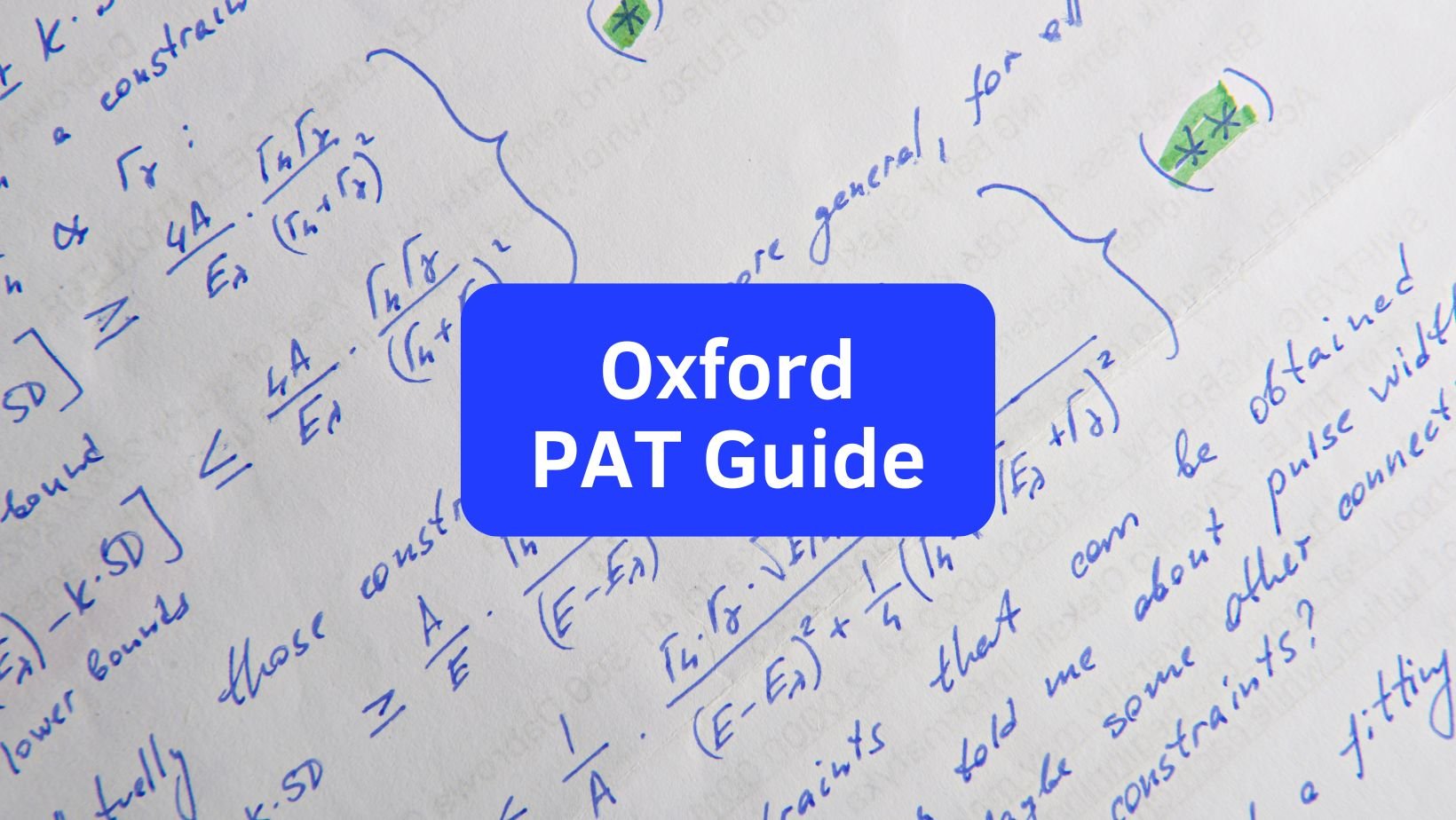Preparing for the Oxford PAT:
Essential Physics Aptitude Test Tips and Practice Questions for 2024
What is the Oxford PAT?
The Oxford PAT, or the Physics Aptitude Test is an online admissions test for the University of Oxford that must be sat by all students applying to study:
Physics
Physics and Philosophy
The exam is 2 hours long and consists of a blend of maths and physics multiple choice questions in a computer-based test. You cannot use any formula sheets or data books but you will be granted access to a digital calculator as part of the exam interface. All students must register to sit the Oxford PAT at a registered centre by early October (though registration is open from August!). You will then sit the Physics Aptitude Test at the end of October.
The Oxford PAT is meant to be a highly challenging exam to identify top applicants for these courses. In 2023, the mean score for the Oxford PAT was 55.6%. Don’t expect to get full marks or obsess over these averages which can vary significantly year to year according to the level of the paper. The Physics Aptitude test is certainly a crucial component of your application to any of these Oxford courses; however, your results are viewed alongside your GCSE results and personal statement.
Starting your Physics Aptitude Test preparation might feel intimidating but this Oxford PAT guide is designed to take some of the stress out of the process. We go over the content of the Oxford PAT exam, including how to approach common Oxford PAT questions, exam technique strategies and how to access further Physics Aptitude Test past papers to give you lots of opportunities to practice and build your confidence for the Oxford PAT exam.
Understanding Oxford PAT Questions
The Oxford PAT is designed to only include content you should have already covered at school, i.e. content from the first year of A-level (or equivalent) Maths and Physics, as well as some content from GCSE. This means you don’t need to start teaching yourself your future university course to be able to do the Physics Aptitude Test!
You should start your Physics Aptitude Test preparation from the Oxford PAT syllabus, available here. While you should have theoretically covered everything at school, don’t assume this is true! There is some variation across what different exam boards cover, or the order in which your school teaches content so you may encounter topics that you haven’t actually studied yet or have only looked at briefly. For example, students taking the Physics Aptitude test are often underprepared for some electricity and magnetism topics, as well as topics like planetary motion which often aren’t covered in school. If you encounter new topics, try and make time to speak to your teacher about them, or arrange a session with a private tutor specialised in the Oxford PAT who can work through the Oxford PAT syllabus to identify unfamiliar areas and can introduce new content, as well as support with exam technique.
It’s important you spend a lot of your Physics Aptitude Test preparation ensuring you have a solid knowledge of these subjects and are comfortable applying them to harder questions. As you go through your A Level knowledge, try and push yourself deeper than the A Level exam requires. For example, think about proofs even if they aren’t examinable, understand how the results and concepts fit together to get you thinking in the style required for the Oxford PAT exam.
Have a go at this Oxford PAT Practice Question:
HINT: Assign variables to the numbers of each colour of button and try to convert the information in the question into a set of equations.
You can find the full solution here.
Tips for approaching Oxford PAT Questions
Take a second before diving in
While the exam is time-pressured, don’t leap into answering the question without having taken a minute to think about it as you are much more likely to make mistakes. Ask yourself how it is best to approach the question, e.g. algebra or a picture?
If you’re stuck, a good place to start is to consider what you do know.
Find concepts or results that resemble the question you’re faced with and try to make a connection
It might be simpler than it looks
Some questions can look much more intimidating than they are! This is often an intentional way to scare students but if you take time to look past the complicated algebra or whatever else it is that’s phasing you in the question, you might find that what it’s asking you to do is actually not that complicated. Equally, don’t always assume that a question will need lots of hard maths to reach an answer; sometimes questions really are just asking you to count or compare answers!
Look at the bigger picture
Often it helps to see the general point or grasp something intuitively before (or instead of) focussing on specifics. What is this question really asking you to do?
Looking for support with the Oxford PAT?
An Oxford PAT tutor is a wonderful way to support your Physics Aptitude Test preparation. Tutors can work with you to ensure you have a solid grasp of the whole PAT syllabus, introducing new topics in easy to understand ways and testing to ensure your understanding. An Oxford PAT tutor can hold sessions on:
Calculus and Series
Electromagnetism and Optics
Graphing Techniques and Geometry
and much more, tailoring content to meet the students needs.
Working with an Oxford PAT tutor will push your understanding of Maths and Physics far beyond the A Level syllabus, encouraging you to apply your knowledge with in-depth PAT practice questions. A tutor will provide supplementary physics aptitude test questions and answers and extensive feedback, working through problems one-to-one and tailoring their support to target the student’s weakest areas and ensure they are ready for the Oxford PAT exam.
Five Tips for your Physics Aptitude Test Preparation
Time management
It’s important to have a strategy that works for you for the Oxford PAT. The exam is time pressured so you need to work effectively to gain all the marks you can. One of our Oxford PAT tutors recommends going through the paper before you start answering questions and identifying and noting down questions which seem easier so you can start from these and confidently bag marks but with lots of past paper practice, you should find a technique that works best for you.
Learn Standard Techniques
Work on familiarising yourself with standard techniques that come up frequently in the Oxford PAT. You could make a list of these as you go through Physics Aptitude Test past papers and notice recurring techniques. Some examples are: symmetry in resistor pyramid problems, Newtonian vs. Lagrangian derivations for SHM, and graphical approaches for rest-acceleration problems.
Practise, practise, practise
The most important way you can build skills for the Oxford PAT exam is by practising with Physics Aptitude Test past papers and other resources. Start your preparation early and work frequently through past papers, from the oldest to the newest. It’s important to mark these papers and get feedback on them from a teacher or tutor.
You should think critically about your performance: where did you lose marks? Are you making the same kind of mistake multiple times? Find general things that are costing you marks. For example: time management, not using previous parts of the question, getting stuck into messy algebra when there’s a neat geometrical method! An Oxford PAT tutor is able to mark and provide extensive critical feedback on your Physics Aptitude Test past papers, as well as set further PAT testing mock exams tailored to the questions you find most challenging and offer strategies to solve any recurring issues. Find out more.
Answer all the questions
As the exam is multiple choice, it doesn’t make sense not to put down an answer for every question. You don’t want to be guessing or run out of time, but if it comes to it, it’s better to have an answer than no answer!
Avoid silly mistakes
Many Oxford PAT students make silly mistakes in their papers either because they are rushing through and not reading questions properly or not leaving enough time to check their answers at the end. Make sure you leave enough time in your exam strategy to check through your answers. You can do quick sanity checks on answers to see if they make sense physically, e.g., checking tension in a pulley system if acceleration is zero.
Remember: the new online format of the exam means that your workings won’t be seen or marked.
Practising with Physics Aptitude Test Past Papers
While the structure of the Oxford PAT has changed, the syllabus remains the same. This means that the existing resources and practice resources available on the Oxford website are still highly useful for your Physics Aptitude Test Preparation. You can access Physics aptitude test questions and answers in Oxford’s PAT workbooks and solution manuals available here. You can also find previous Physics Aptitude Test past papers to practise with, here. Just remember that the exam format will be different. There is currently only one sample test available in the current format which it’s also important to go through and practise with.
U2 has a team of Oxford PAT tutors who are able to create further supplementary tests in the style of physics aptitude test past papers to give you more opportunities to practise and get used to the new exam format. As few of the Physics Aptitude Test past papers available online have worked solutions or answers, tutors are also able to mark Physics aptitude test past papers and provide highly valuable feedback and strategies to improve technique and overall performance.
Further PAT Practice Questions and Resources
There are also some other useful resources and sites where you can find questions in the style of the Oxford PAT, giving you further PAT practice questions to work with. We recommend:
Isaac Physics: Isaac Physics has some great questions online that you can choose the level of. Level 4-5 tends to be about the same level as the Oxford PAT and offers some useful PAT practice questions.
British Olympiad: The British Olympiad site publishes past questions and answers in the past paper section. The Senior Physics Challenge and Physics Challenge are particularly useful PAT practice questions.
Professor Povey's Perplexing Problems: This book is filled with exercises and explanations that are a good level for PAT test practice.
I Want to Study Engineering: This site has questions at a range of levels for Maths and Physics. The section “Mathematics and Physics problems at the level of university Engineering admissions interviews” has some questions in a similar style to the Oxford PAT exam.
How Can U2 Help You Prepare for the Oxford PAT & Wider Oxford Application Process?
U2 Tuition offers comprehensive support for students preparing for the Oxford Physics Aptitude Test (PAT) as part of our wider Oxbridge mentoring programmes or through individual tuition sessions. Whether you’re applying for Engineering, Materials Science, Physics, or Physics and Philosophy, our team is here to guide you every step of the way.
Our Process:
1) Tailored Tutor Matching: We suggest a tutor who is an Oxford graduate in Physics, Engineering, or a related field, with extensive experience in preparing students for the Oxford PAT. Many of our mentors have postgraduate qualifications and in-depth familiarity with the admissions process for these subjects. Their understanding of the PAT exam and interview process is invaluable to student success.
2) Initial Assessment: We typically begin with a 1.5-hour informal assessment, during which the mentor evaluates the student’s current strengths and weaknesses. Based on this session, we provide a detailed report with feedback and a structured plan for Oxford PAT preparation.
3) Regular PAT Sessions: Through structured sessions, tutors will focus on teaching students to identify patterns in PAT questions and hone their problem-solving techniques, going beyond the A-Level syllabus. This involves working through difficult concepts in Physics and Maths, and focusing on areas where students can make significant gains. Our tutors provide extensive feedback on past papers, set mock exams, and work with students on time management strategies, all while ensuring the student builds confidence for both the PAT and interview stages.
Wider Oxbridge Application Support
Beyond PAT preparation, U2’s Oxbridge programmes aim to advance students to the level required for success at interview through regular tutorials and specific admissions preparation. In sessions, students are expected to explain and defend ideas, solve complex problems, and think critically in conversation with the tutor, mirroring the style of an Oxbridge tutorial.
We provide tailored support across the whole application process, including:
For more information, you can book a free consultation with us to discuss your needs.
Sessions start from £70/h + VAT.






